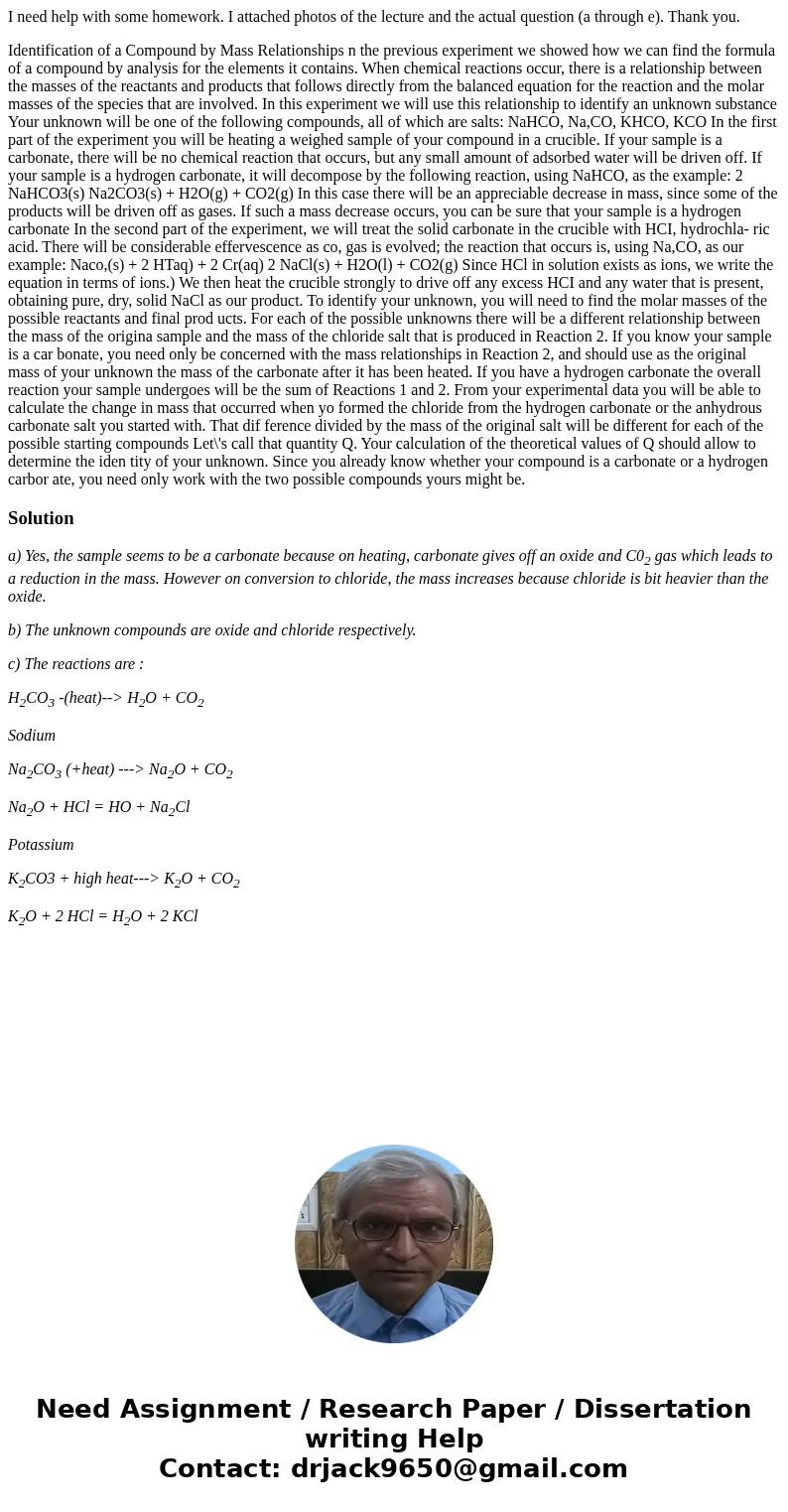I need help with some homework I attached photos of the lect
I need help with some homework. I attached photos of the lecture and the actual question (a through e). Thank you.
Identification of a Compound by Mass Relationships n the previous experiment we showed how we can find the formula of a compound by analysis for the elements it contains. When chemical reactions occur, there is a relationship between the masses of the reactants and products that follows directly from the balanced equation for the reaction and the molar masses of the species that are involved. In this experiment we will use this relationship to identify an unknown substance Your unknown will be one of the following compounds, all of which are salts: NaHCO, Na,CO, KHCO, KCO In the first part of the experiment you will be heating a weighed sample of your compound in a crucible. If your sample is a carbonate, there will be no chemical reaction that occurs, but any small amount of adsorbed water will be driven off. If your sample is a hydrogen carbonate, it will decompose by the following reaction, using NaHCO, as the example: 2 NaHCO3(s) Na2CO3(s) + H2O(g) + CO2(g) In this case there will be an appreciable decrease in mass, since some of the products will be driven off as gases. If such a mass decrease occurs, you can be sure that your sample is a hydrogen carbonate In the second part of the experiment, we will treat the solid carbonate in the crucible with HCI, hydrochla- ric acid. There will be considerable effervescence as co, gas is evolved; the reaction that occurs is, using Na,CO, as our example: Naco,(s) + 2 HTaq) + 2 Cr(aq) 2 NaCl(s) + H2O(l) + CO2(g) Since HCl in solution exists as ions, we write the equation in terms of ions.) We then heat the crucible strongly to drive off any excess HCI and any water that is present, obtaining pure, dry, solid NaCl as our product. To identify your unknown, you will need to find the molar masses of the possible reactants and final prod ucts. For each of the possible unknowns there will be a different relationship between the mass of the origina sample and the mass of the chloride salt that is produced in Reaction 2. If you know your sample is a car bonate, you need only be concerned with the mass relationships in Reaction 2, and should use as the original mass of your unknown the mass of the carbonate after it has been heated. If you have a hydrogen carbonate the overall reaction your sample undergoes will be the sum of Reactions 1 and 2. From your experimental data you will be able to calculate the change in mass that occurred when yo formed the chloride from the hydrogen carbonate or the anhydrous carbonate salt you started with. That dif ference divided by the mass of the original salt will be different for each of the possible starting compounds Let\'s call that quantity Q. Your calculation of the theoretical values of Q should allow to determine the iden tity of your unknown. Since you already know whether your compound is a carbonate or a hydrogen carbor ate, you need only work with the two possible compounds yours might be.Solution
a) Yes, the sample seems to be a carbonate because on heating, carbonate gives off an oxide and C02 gas which leads to a reduction in the mass. However on conversion to chloride, the mass increases because chloride is bit heavier than the oxide.
b) The unknown compounds are oxide and chloride respectively.
c) The reactions are :
H2CO3 -(heat)--> H2O + CO2
Sodium
Na2CO3 (+heat) ---> Na2O + CO2
Na2O + HCl = HO + Na2Cl
Potassium
K2CO3 + high heat---> K2O + CO2
K2O + 2 HCl = H2O + 2 KCl

 Homework Sourse
Homework Sourse